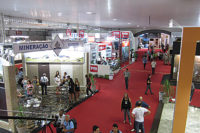It is no secret that the Brazilian granite industry has grown tremendously over the course of the last decade. In the early 1990s, Brazilian granite suppliers began seriously marketing material to the American market, and exports of granite from Brazil to the U.S. reached a total of $19.5 million in 1994. Five years later, that total reached $42.9 million, and by 2004, a total of $267.9 million worth of Brazilian granite was exported to the U.S., placing Brazil a close second behind Italy in terms of granite exports to America.
As remarkable as this 10-year growth period appears, perhaps the most notable increase came just last year. According to U.S. Customs data, exports of granite from Brazil to the U.S. are projected to reach a final total of $365.7 million for 2005. This marks a rise of over 33% from 2004, and places Brazil well ahead of any other nation in terms of granite exports to the U.S. (Italy projects to be second in this category, exporting $275.8 million worth of granite to the U.S. in 2005, although it clearly remains the leader in overall stone exports to the U.S.)
The driving force behind this growth has clearly been the granite kitchen countertop, as homeowners throughout the U.S. are selecting granite for their residences with ever-increasing frequency. Brazil's abundance of granite colors and varieties has fit in extremely well with the tastes of these homeowners, and materials such as Ubatuba, Giallo Veneziano and Verde Butterfly have become staples in the shops of many stone fabricators. Of course, the exotic granite choices from Brazil are also plentiful, appealing to homeowners looking for a truly one-of-a-kind look.
However, perhaps just as important as Brazil's natural resources is the development of the country's stone industry. The advanced slab-producing plants in Brazil are equipped with state-of-the-art Italian stoneworking machinery, and they are comparable with the finest plants in the world - including those in Europe. In fact, many of the plants in Brazil are owned and operated by European companies - blending Brazil's unique resources with European stoneworking knowledge and expertise.
Of course, this is no secret to the many U.S. stone distributors and suppliers who visit Brazil each year, and their numbers are steadily increasing. When I attend the Vitoria Stone Fair in Brazil each year, I am seeing more and more familiar American faces in the exhibit hall - as well as in the modern slab-producing plants throughout the Espirito Santo stoneworking region. In many ways, the Vitoria Stone Fair (previewed on page 52 of this issue) is developing the feel of Marmomacc in Verona, Italy, where visitors from around the world come to see the latest trends in natural stone - both at the exhibit hall and in the production stage.
In this issue of Stone World, we take a deeper look at the growth taking place in Brazil and Latin America as a whole (page 56), and we also look at some state-of-the-art stoneworking plants in the region. It is an exciting time for the Brazilian stone industry, and it is gratifying to see that they are carefully developing their craft and maintaining natural stone's reputation as a premier building material.
Stone Column: Brazil's Exploding Granite Industry

